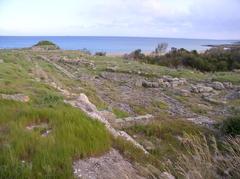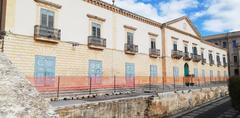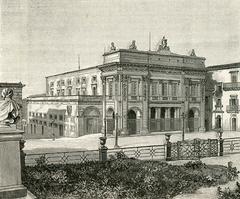Canicattini Bagni Visiting Hours, Tickets, and Historical Sites in Noto, Italy
Date: 14/06/2025
Introduction
Nestled in southeastern Sicily, close to the UNESCO-listed Baroque city of Noto, Canicattini Bagni offers a fascinating blend of ancient heritage, artistic architecture, vibrant culture, and unspoiled natural landscapes. This guide provides a detailed overview of Canicattini Bagni’s historical roots, Liberty (Art Nouveau) treasures, outdoor adventures, and practical information—ensuring you have everything you need for an enriching visit.
Whether you are passionate about archaeology, architecture, hiking, or Sicilian gastronomy, Canicattini Bagni promises an authentic and memorable experience away from the usual tourist trails. For up-to-date information, interactive maps, and virtual tours, consult official local resources and cultural platforms such as Audiala, sicily.co.uk, enjoysicilia.it, and comunedicanicattinibagni.it.
Table of Contents
- Discover Canicattini Bagni: A Journey Through Sicily’s Archaeological Heritage
- Liberty Architecture and Historical Richness
- Outdoor Activities and Natural Attractions
- The Sanctuary of San Paolo and Local Culture
- Summary and Key Visitor Recommendations
- References and External Links
Discover Canicattini Bagni: A Journey Through Sicily’s Archaeological Heritage
Ancient and Medieval Settlement Patterns
Archaeological research reveals that Canicattini Bagni has been continuously inhabited since prehistoric times. The area’s earliest settlements—dating from the Neolithic and Bronze Age—exploited fertile land and proximity to the coast, as evidenced by hut remains and C-shaped ditches (academia.edu). Later, the Siculi, Greeks, and Romans left their mark through toponyms, ruins, and the introduction of roads, aqueducts, and rural villas.
During the Byzantine and medieval periods, the area saw both continuity and transformation, including the establishment of rural churches and fortified farmsteads. Islamic rule brought new building techniques and pottery traditions, enriching the local cultural tapestry (academia.edu).
Modern Canicattini Bagni was founded in the early 17th century, its urban layout and architecture reflecting the Baroque and Liberty movements (sicily.co.uk).
Key Archaeological Sites & Museums: Visiting Hours and Tickets
Archaeological Museum of Memories
- Hours: Tuesday–Sunday, 9:00 AM–6:00 PM
- Tickets: €5 adults, €3 concessions; free for residents
- Highlights: Artifacts from Greek, Roman, and Byzantine periods, along with medieval pottery (sicily.co.uk)
Museo del Tessuto, dell’Emigrante e della Medicina Popolare
- Hours: Tuesday–Sunday, 10:00 AM–5:00 PM
- Tickets: €4 adults, €2 children; group discounts available
- Exhibits: Traditional textiles, crafts, and local customs
Tip: Always check official sites or contact the museums before visiting, as hours and ticketing may vary seasonally.
Sacred Architecture and Monuments
- Church of Santa Maria Ausiliatrice: Late 18th-century church with Liberty details
- Baroque Church of Anime Sante del Purgatorio: 1700s church with 1904 Liberty additions
- Mother Church of Santa Maria degli Angeli: Early 19th century, with significant artistic elements
These churches are open during standard hours, and many are accessible to those with mobility challenges.
Exploring Further
Combine your archaeological exploration with visits to nearby Baroque towns (Noto, Modica, Ragusa) for a comprehensive understanding of the region’s layered history.
Liberty Architecture and Historical Richness
Canicattini Bagni is renowned for its unique concentration of Liberty (Art Nouveau) architecture—a testament to the town’s prosperity and artistic ambitions in the late 19th and early 20th centuries (enjoysicilia.it). Local stonemasons, notably Santo Aiello and Sebastiano Bonaiuto, left a lasting legacy on the town’s streetscapes.
Notable Liberty Artisans and Works
- Santo Aiello: Renowned for intricate stone façades on churches and residences, particularly along via Regina Elena and via Vittorio Emanuele.
- Sebastiano Bonaiuto: His work is evident in the Maria Ausiliatrice Church, Villa Comunale, noble cemetery chapels, and the Mother Church’s baptismal font.
Urban Fabric & Self-Guided Tours
Key streets—via Regina Elena, via Vittorio Emanuele, via Principessa Jolanda, via Umberto, via Dante Alighieri—offer a walking itinerary rich in Liberty features: wrought iron balconies, stucco motifs, and colorful mosaics.
Archaeological and Historical Layers
Sites such as the Contrada Cugno Case Vecchie necropolis and the “great crater of Canicattini” (now in the Museo Archeologico Regionale Paolo Orsi, Syracuse) highlight the region’s artistic and historical depth (Wikipedia).
Visiting Hours and Accessibility
- Church of Purgatory: Open daily, 9:00 AM–12:00 PM & 4:00 PM–7:00 PM; free entry
- Museums: See above for hours and ticket info
- Accessibility: Most public sites are wheelchair accessible; some historic buildings may have limitations—contact local tourism offices for details.
Local Events & Workshops
Summer artisan festivals and workshops offer insight into traditional crafts. Guided Liberty architecture tours are available; advance booking is recommended.
Outdoor Activities and Natural Attractions
Geographic Setting
Perched 362 meters above sea level on the Hyblean Plateau, Canicattini Bagni is surrounded by limestone formations, olive groves, and deep quarries (locally called “cave”) (enjoysicilia.it). Streams like the Cavadonna create lush habitats for endemic flora and fauna (comunedicanicattinibagni.it).
Hiking and Walking Trails
Over 70 mapped hiking trails cater to all levels (wikiloc.com). Notable examples:
- Le Scale di Cavadonna: 17 km, features ancient stone steps and panoramic views
- Cugni e Cave di Canicattini Bagni: 51.7 km, explores quarry landscapes
- Canicattini Bagni - Porta Noto Antica - Santa Lucia: 155.5 km, ideal for multi-day hikes
Trail Highlights: Grotta Genovesi (geological/archaeological site), Valle dell’Anapo (ancient ruins and scenic railway, also popular for cycling) (komoot.com).
Cycling and Mountain Biking
Diverse routes range from gentle rural roads to challenging off-road tracks (komoot.com). The “Canicattini Bagni raduno sfausi” circuit and “Cugni e Cave” trails are favorites among cyclists.
Nature Reserves & Water Activities
- Cavagrande del Cassibile Nature Reserve: Deep canyons, freshwater pools; entrance fee may apply
- Punto Balneabile Fiume Cassibile: Ideal for swimming and picnics
Wildlife and Birdwatching
The area’s fields and streams are habitats for various birds, including raptors and migratory songbirds. Spring and autumn are prime times for observation (comunedicanicattinibagni.it).
Practical Tips
- Best Seasons: Spring and autumn for mild weather and vibrant scenery
- Gear: Wear sturdy shoes, bring water, sun protection, and use GPS apps like Wikiloc or Komoot
- Facilities: Limited outside town—plan ahead for water and snacks
- Accessibility: Some trails are challenging; inquire locally for suitable routes
The Sanctuary of San Paolo and Local Culture
Sanctuary of San Paolo: Historical Overview & Visitor Info
Built in the late 17th century, this sanctuary is dedicated to Saint Paul and stands as a symbol of Canicattini Bagni’s Catholic heritage and Baroque influences. The façade and frescoes are notable artistic highlights.
- Hours: Mon–Sat, 9:00 AM–12:30 PM & 4:00 PM–7:00 PM; Sun/holidays, 9:00 AM–1:00 PM
- Tickets: Free entry; donations encouraged
- Guided Tours: Available on request for groups—reserve with the local tourist office
- Accessibility: Wheelchair accessible
Cultural Life, Festivals, and Gastronomy
Canicattini Bagni is known for its strong community spirit, expressed through public squares, artisan workshops, and a lively calendar of events (siracusa-sicilia.it). Key festivals include the Feasts of St. John the Baptist and St. Paul, featuring processions, music, and communal meals (enjoysicilia.it).
Culinary Highlights:
- Caponata, Pasta alla Norma, Trapani-style pasta, Fritto misto, Cannoli, Cassata (authenticfoodquest.com; italyweloveyou.com)
- Top venues include agriturismi, trattorias, and bakeries such as L’Antico Forno Bellomia (restaurantguru.com)
Markets: Weekly local markets offer seasonal produce, cheeses, cured meats, and traditional sweets.
Getting There & Around
- Transport: Regional buses from Siracusa and Noto; car rental recommended for flexibility
- Parking: Available near major sites
Tip: Spring and summer are ideal for festivals and open-air events.
Summary and Key Visitor Recommendations
Canicattini Bagni stands out as a destination where visitors can immerse themselves in the full spectrum of Sicilian history, art, nature, and living tradition. From prehistoric archaeological sites to the striking Liberty architecture, from scenic hiking and cycling trails to celebrated festivals and Sicilian gastronomic delights, the town offers a truly multifaceted experience. Practical infrastructure, accessible museums, and welcoming community spirit enhance the appeal for travelers of all interests and abilities.
Visitor Tips:
- Leverage resources like the Audiala app and official tourism sites for updated guides and maps
- Plan your visit during spring or autumn for the best combination of mild weather and local events
- Respect local customs and natural environments during your explorations
- Combine urban sightseeing with outdoor activities for a well-rounded Sicilian adventure
For further resources and planning, visit sicily.co.uk, enjoysicilia.it, and comunedicanicattinibagni.it.
References and External Links
- Canicattini Bagni travel guide (sicily.co.uk)
- Landscape Archaeology and Historical Cartography (academia.edu)
- Liberty Architecture in Canicattini Bagni (enjoysicilia.it)
- Canicattini Bagni on Wikipedia (Wikipedia)
- Outdoor activities guide (enjoysicilia.it)
- Comune di Canicattini Bagni (comunedicanicattinibagni.it)
- Hiking routes (wikiloc.com; komoot.com)
- Local events (enjoysicilia.it)
- Siracusa Sicilia tourism (siracusa-sicilia.it)
- Sicilian food guides (authenticfoodquest.com; italyweloveyou.com)
- Dining options (restaurantguru.com)




